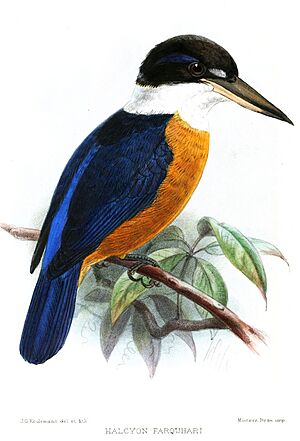Vanuatu kingfisher facts for kids
Quick facts for kids Vanuatu kingfisher |
|
|---|---|
 |
|
| Conservation status | |
| Scientific classification | |
| Genus: |
Todiramphus
|
| Species: |
farquhari
|
The Vanuatu kingfisher is a special bird. It is also known as the chestnut-bellied kingfisher. This medium-sized kingfisher lives only on a few islands. These islands are Espiritu Santo, Malo, and Malakula in Vanuatu.
Contents
About the Vanuatu Kingfisher
The Vanuatu kingfisher has dark blue feathers on its back. Its belly is a rich orange color. It has a white spot in front of each eye. A wide black band runs along the side of its head. Its throat and a band around its neck are white.
This bird is about 19 to 21 centimeters (7.5 to 8.3 inches) long. It weighs between 32 and 42 grams (1.1 to 1.5 ounces). Its call is a series of loud, sharp, piping sounds.
The only other kingfisher in Vanuatu is the Pacific kingfisher. The Pacific kingfisher has lighter blue-green feathers on its back. Its belly is whiter, and it has a buff-colored stripe above its eye.
What Vanuatu Kingfishers Eat
The Vanuatu kingfisher mainly eats insects. Beetles are a favorite food for them. They also enjoy eating spiders and small lizards.
These birds usually hunt by sitting quietly on a branch. They wait for their prey to appear. When they spot something, they fly into the air. Sometimes, they dive down to the ground. They might also dive onto a tree trunk to catch their meal.
Reproduction and Nesting
Vanuatu kingfishers build their nests in interesting places. Sometimes, they make a nest in a hole in a palm tree. They might also use a tree fern.
Most often, a pair of kingfishers will dig a burrow. They make this burrow inside a termite mound on a tree. They use their large bill to dig. Then, they clear out the dirt with their feet.
It takes about fifteen days to finish the burrow. After they are done, the termites seal off their own sections. The female kingfisher then lays three or four white eggs. The main breeding season is from November to February. Eggs are usually laid in December.
Where They Live
These birds mostly live in thick rainforests. They prefer the forests in the middle of the islands. You can often find them above 200 meters (650 feet) in height.
Scientists believe their numbers are going down. This is because their forest homes are being lost. The quality of their forest habitat is also getting worse.


